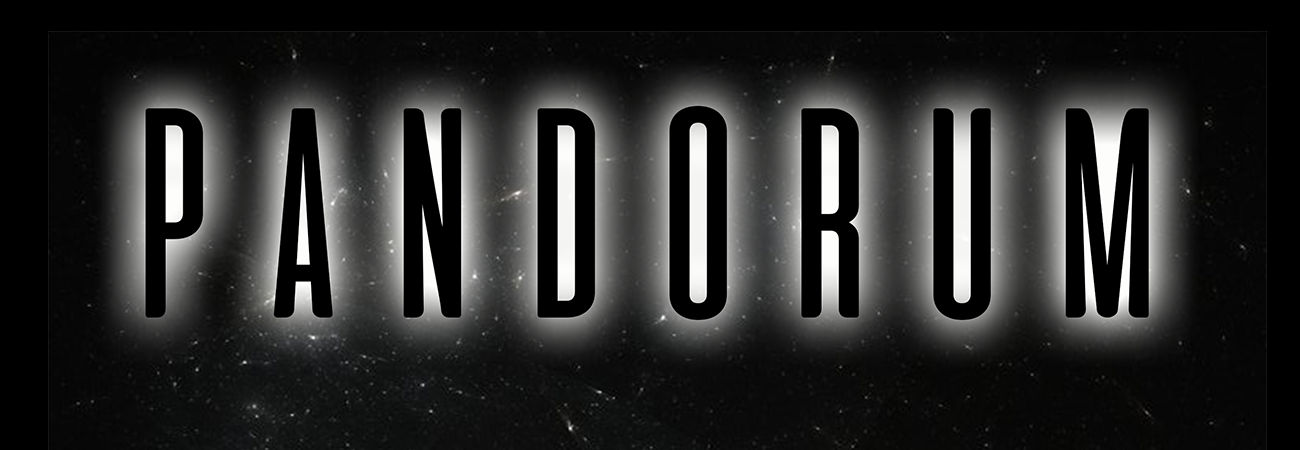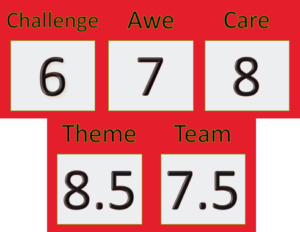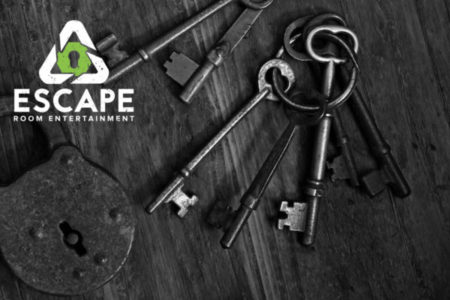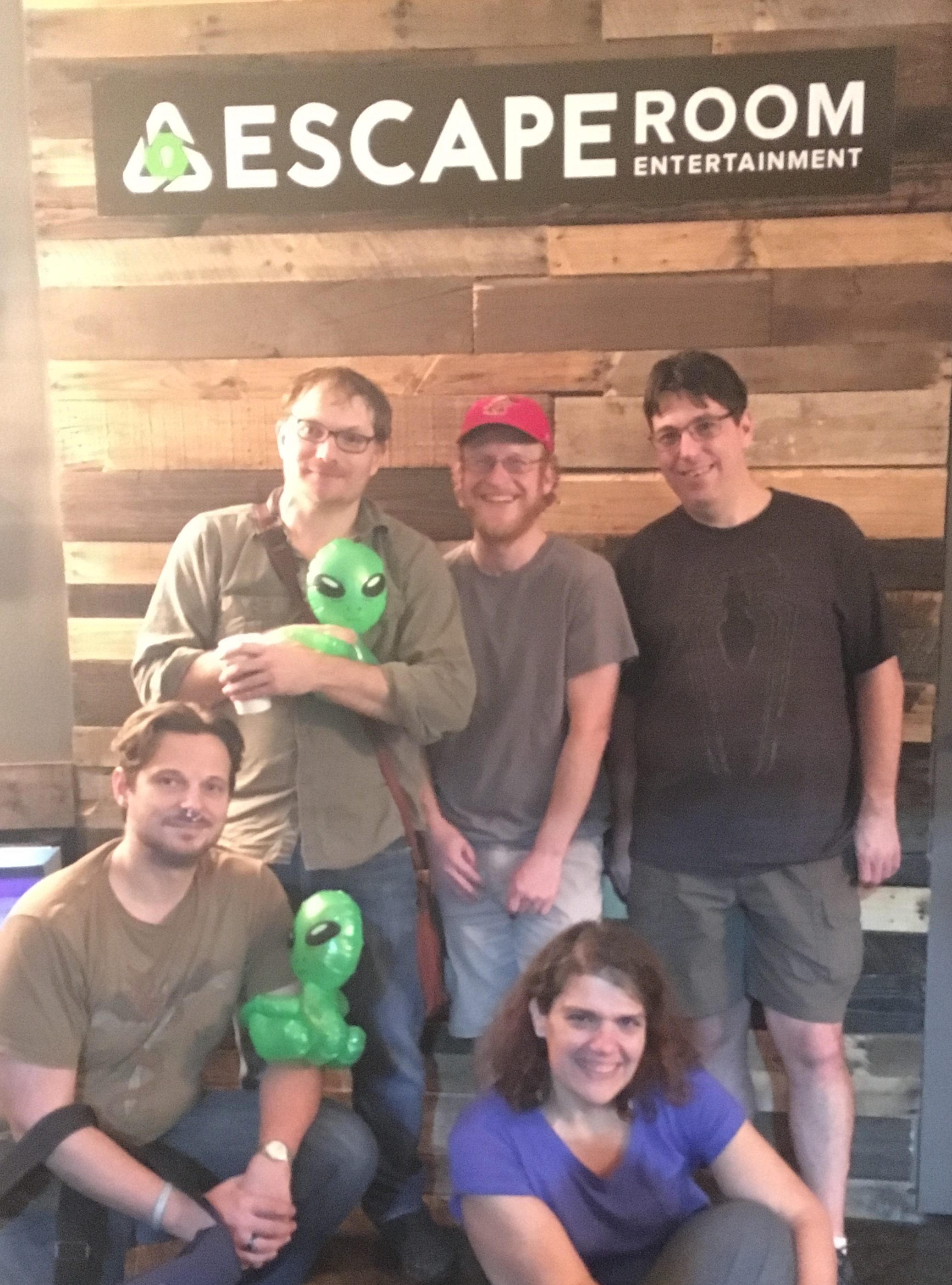


4/5 Claws
Challenge: 6
Awe: 7
Care: 8
Theme: 8.5
Team: 7.5
Signature Color: RED
 Michael:
Michael: 
“Science Fiction and Horror look more compatible than they are. They’re like that couple you think would be really hot together. So you fix them up. But later on, you hear their first date did not go well. Sometimes Pandorum feels like that first date. Sci Fi does all the talking–mostly about itself–and Horror kind of sits there stirring her drink and trying to smile half-heartedly.
This room is hard, and the difficulty of Pandorum comes from its story and its setting, rather than from artificially complicated puzzles. It combines sci fi and horror, but the essential play experience is closer to the tech-puzzles of space-race or moon-landing rooms than anything else. In general, it’s terrific, but it’s going to appeal to those who like to play with buttons and gizmos. You’ll have to figure out how things work, and think like someone trapped in outer space. More horror elements are coming, I’m told. Right now, there’s some blood, and the pinch of terror offers a small shot of adrenaline to help you focus. There might be some places where the two genres corrupt rather than compliment each other. I do think all of us involved with the art form have a lot to learn about genres in general, and this room might end up teaching us a lot. More on that stuff later, though.
Visually, this room is very cool. It really does feel like being on a spaceship where the shit has hit the fan and you’re probably doomed, though again, it’s more claustrophobic than urgent or threatening. It is quite challenging. We did not survive. But I think it’s pretty fair. If anything could use a fairness re-think, it would be those challenges which are made hard by the light level; I question (without condemning) the combination of technical precision puzzles with literal darkness, because everybody has a different level of eye-sight–and not just near- or far-sightedness, there’s great variation in sharpness, color-perception, and a lot of other factors. It’s different with other physical difficulties; a person knows if he can or can’t crawl under something or reach something. If you’re not colorblind, but you just don’t differentiate color as well as you think you do, you’ll be at a disadvantage without knowing it.
The darkness makes it feel much more urgent, but it also just makes it harder to effing see, which has the oddly comic effect of making the monster-aliens seem more petty than menacing; like they’re peeing in my shoe, not like they’re about to rip off my head and make a baby in my neck. Also, horror often plays with teams by forcing one player to do the scary thing, to suffer the jump-scare or enter the dark room first, while everyone else watches. The designers made a very effective all-hands-on-deck experience, but unlike the bothersome darkness, that’s also an area where horror could have been brought in at a deeper level to make a more convincing hybrid.
Also, a warning: the room gave us some false negatives; a couple times we had completed puzzles but the reaction we were told to expect didn’t happen. This venue cares a lot about improving their rooms, so don’t be afraid to ask them if you have a puzzle right, in case some mechanism just isn’t triggering like it should.
Don’t feel bad if you make it into, but not out of, the third and final stage. That’s where the game, while still awesome, starts to wander from its own established style of reasoning. The logic shifts and is suddenly incongruous with the rest of the game. In a room with so many technical elements, it’s ideal if the last stage feels like only an expert in the technology you’ve just learned could solve this final challenge; and that the players are just the experts it needs. This part of Pandorum really does come close. But it suddenly introduces… hieroglyphics? I mean, it isn’t hieroglyphics, exactly, I’m avoiding spoilers, but suddenly there are hidden decoder-symbols where no crew would ever encrypt anything, and superfluous steps added to otherwise logical uses of equipment. It’s dissonant. But not too outrageous, the room stays fun and the challenge stays high. And more importantly, this game is one of the best around. The story’s great, it’s pure and makes the spaceship make sense, but some elements of the endgame’s puzzles could feel less arbitrary.
That kind of leads me to the more theoretical level (stop reading if you don’t care) we all know what horror and sci fi look like superficially. But is there a fundamental difference in the nature of the puzzles that support each of those thees? The kinds of challenges that seem native and appropriate to those genres seem to differ from each other at the deepest levels, and that’s something this room brought to my attention. In our color-coding system, we think of them as red (“panic”) and blue (“tech”) and this room only reinforced the stark division of those categories.
For horror, when the room is dark, the puzzles are usually big–like body parts–or shocking, so that once you find the components, they really stand out. In bloody / corpse-y rooms where players are menaced by giggling murder-clowns (or what have you) the room’s puzzles all basically have the villain’s personality–and as the players get closer to success, the puzzles become more serious and horrible even as they get less clever–as if the enemy is getting desperate, and more careless. The players feel like they barely survived. In sci-fi / tech rooms, the personality of the room’s puzzles mirrors the personality of absent human experts: lost crewmen in this case, or sometimes brilliant inventors who left their cryptic instruments behind, along with notes from others who tried and failed to figure them out.
The darkness horror needs interferes with the precision element of the technology-themed challenges. It’s hard to show off your seat-of-the-pants tech wizardry, if nobody can see you doing it. And it’s hard to feel scared if you’re all ticked off because you just can’t read the hyper-god-damn-whatchamacal-itron.
So do the horror elements help or hinder the fun of the challenges? Paul’s got some really insightful things to say about this, see below.
Not recommended for fewer than 3 people. Also, any more than 6 people and that spaceship is gonna be painfully cramped. ”
 Paul:
Paul: 
“I was thrilled to get to play Pandorum on opening day! We first heard about its development when we came to town about eight months ago and have been looking forward to it ever since. Sadly, I think being so eager damaged by the experience and even though I may not have enjoyed it personally, I respect it.”
The setting is an outer space horror story in the vein of the film Alien and the sets are both elaborate and effective. Michael and I had a long debate about Pandorum‘s Signature Color; while he is right that the consistency of the setting and its integration into the challenges focuses almost exclusively on the scientific and technological inspirations (as is typical of “blue” rooms, in our color-coded system), many of the most impactful design decisions, such as the deliberate darkness and oppressive confinement of the floorplan, were made specifically to cultivate the fear-based panic characteristic of Red Rooms. While reaching a decision on this front wasn’t easy is a testament to Escape Room Entertainment’s ability to surprise players with a familiar theme in an atypical way.

There were still a few bugs to work out on our play through, and they were a direct result of the ‘space/horror’ execution. Their choice to make the room so damn dark is one of my biggest problems with the experience. Once out of the first stage, players are restricted from bringing white-light flashlights with them into the subsequent areas; only red or green flashlights were allowed (and exceptionally dim ones at that). This made it extremely difficult to solve any of the otherwise reasonable color-based puzzles in the rest of the room, but the difficulty was not satisfying or compelling. It was like trying to do the challenges with one hand tied behind my back. A better execution would have shapes, rather than colors, used to convey information. As it is, many of the puzzles involve only circles. In short, the theme was so effectively executed that it actually detracts from the challenges.
There was really no accurate way to gauge our progress as time wore on. Often we would be supplying the correct answers but thought we were wrong because nothing seemed to react to what we were doing; the springs that would normally have popped open compartments when unlocked (thus providing critical feedback to the players that they had completed a puzzle) had been delayed in shipping. Even now, after having been walked through the final three challenges, I couldn’t tell you how many puzzles are in this room over all, mostly because, in the dark, there wasn’t a way to ever fully absorb everything that needed addressing.
The real shame in this is that it prevented us from really appreciating how varied and compelling the challenges themselves were! A fantastic mix of types relying on observation, logic, and tactility, the puzzles in Pandorum allow every team member to contribute, even those who tend to get a little silly under pressure.
There are some extremely novel elements that could have could have been far more memorable, if only we had been able to actually see them [Editor: because of the darkness, not the team’s lack of progress].
I really do recommend this room, even though I personally enjoy some major aspects of it; I just wish the puzzles would be allowed to shine a bit more. Hopefully, ERE can find some more-suitable flashlights; even colored lights would be fine if they were just a bit stronger.”


8580 Palm Parkway
Orlando, FL 32836
(406) 778-5800
Read more posts in the category:
Review
More posts from:
August 2017 / All of 2017